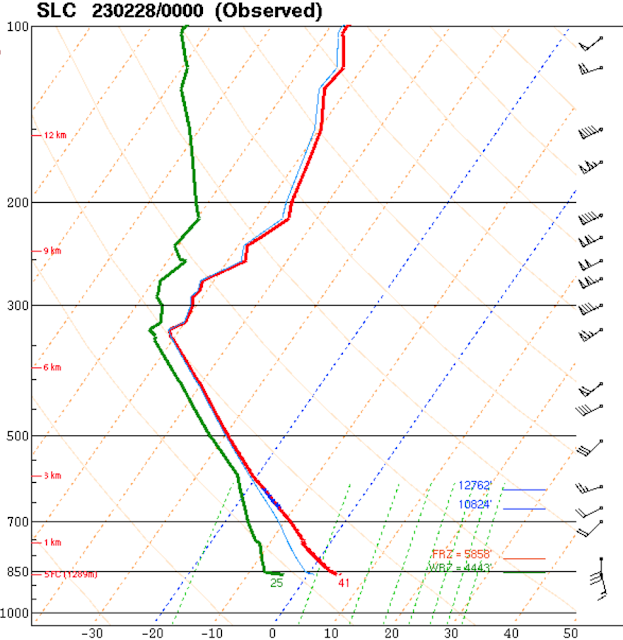Super excited for the events to unfold later today through Wednesday. The models continue to be on track with a major, all elevations snow event for Utah.
The large-scale setup for this event is an amplifying upper-level trough that digs southward along the Pacific Coast. As discussed in an earlier post, this amplifying system is actually connected to the development of two powerful cyclones over the northwest Pacific, which amplify the immediate downstream ridge over Alaska, which in turn amplifies the trough along the Pacific Coast through a process known as downstream development. The GFS forecast valid at 0000 UTC 22 February (5 PM MST Tuesday) shows all of these features nicely with the northwest Pacific cyclones marked with Ls, the ridge with a zig-zagged line, and the trough with a dashed line.
This is a highly dynamic situation with rapid amplification of the jet-stream pattern. It is only through the power of numerical weather prediction that such a pattern change can be reliably anticipated days in advance. We've been on alert for some time about this possibility, even if the details could not be confidently pinned down.
As the upper-level trough digs down the Pacific Coast, the accompanying cold front slides into Utah. The GFS forecast valid 0000 UTC 22 February (5 PM MST Tuesday, corresponding to the valid time of the hemispheric forecast analysis above), shows the cold front over central Nevada and northern Utah. To the south of the front it is mainly dry. To the north, heavy precipitation mainly in the form of snow.
Note the sharp wind shift at 700-mb (10,000 ft above sea level) in the lower left hand panel above. This is reflective of strong troughing that develops along the front downstream of the Sierra Nevada and extending across central Nevada and Utah.
Eventually the cold front and associated trough become the locus for cyclogensis, falling pressures and the development of a low-pressure system over Utah. By 1200 UTC 22 February (5 AM Wednesday), the low pressure system is centered over eastern Utah.
In response to the developing cyclone, the front pivots over central Utah, surging southward through Nevada to the west, but stalling over the Uintas to the east. The pivot point is somewhere near Provo, give or take 100 kilometers. At 700-mb, a fully closed circulation develops that is roughly centered over Kamas at1200 UTC 22 February (5 AM Wednesday, lower left panel above). This makes anticipating mountain effect on precipitation very difficult as much will depend on the track of that closed circulation and wind directions could change quite a bit during its passage. Additionally, much will also depend on how far south the front pushes.
I'll walk you through one model solution. This is the high-resolution HRRR initialized at 1200 UTC (5 AM MST) this morning. The forecast valid 1800 UTC 21 February (11 AM MST Tuesday) shows the front just beginning to push into northwest Utah with some prefrontal precipitation over the central Wasatch, northern Wasatch, northern Wasatch Front, and Cache Valley. Precipitation at this time would be valley rain and mountain snow, with perhaps some wet snow on high-elevation benches.
By 0000 UTC 22 February (5 PM MST Tuesday), the front is on the doorstep of the Salt Lake Valley. It is likely that precipitation has changed to snow at all elevations along the northern Wasatch Front and its probably just about to change to snow in the Salt Lake Valley. Buckle up!
By 0300 UTC 22 February (8 PM Tuesday), the front has pushed through Tooele County and is entering Utah County at the surface, although the band is covering much of northern Utah County and southern Salt Lake County. Expect heavy snowfall over the Salt Lake Valley this evening as the band moves through.
Then the front stalls and begins to pivot. The sequence of images below shows the frontal band lingering in the Wasatch Front region through 1500 UTC 22 February (8 AM MST Wednesday).
Periods of snow would likely occur in the Salt Lake Valley through that period, and then continuing into the day on Wednesday. Accumulations will vary spatially and depend on local flow interactions with terrain.
The HRRR-derived snowfall forecast through 1500 UTC 22 February (8 AM Wednesday) is below. I'll focus on accumulations through 8 AM tomorrow as that's a good time for both commuters and skiers, although periods of snow may continue through Wednesday. The HRRR-derived snowfall forecast uses our University of Utah snow-to-liquid-ratio algorithm. It calls for a big dump for the entire Wasatch Range with 18+ inches at all central Wasatch Resorts, 22 at Snowbasin, and 26 at Powder Mountain through 8 AM tomorrow. The range in the Salt Lake Valley is from about six or seven inches to just over a foot at Cottonwood Heights. If this forecast were to verify, the southeast bench would get the most snow in the valley.

That's just one model run. If we look at the downscaled SREF forecast for Alta-Collins, there is remarkably tight clustering. By 22/15Z, corresponding to the period plotted above and through 8 AM MST Wednesday, the vast majority of members lie between 17 and 26 inches, although there are a few that are above that.
The spread in the valley is greater, which reflects both precipitation amount and temperature uncertainties. Through 22/15Z, the range is from about 2 inches to 9 inches for the University of Utah Mountain Meteorology lab.
Bottom line is a significant event is on tap. Below is the official Winter Storm Warning issued by the National Weather Service this morning for the Tooele and Rush Valleys, Northern Wasatch Front, Salt Lake Valley, and Utah Valley.
 |
NWS Winter Storm Warning issued 6:26 AM Tuesday February 21. Captured 9:10 AM 21 February 2023.
|
Note that accumulations in that warning cover the period from 5 PM this afternoon to 11 PM MST Wednesday and thus are somewhat higher than I discussed through 8 AM Wednesday.
Monitor forecasts and buckle up.


























.png)
























